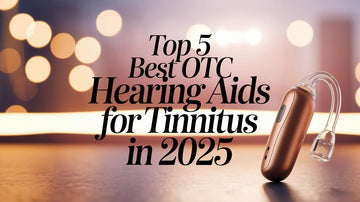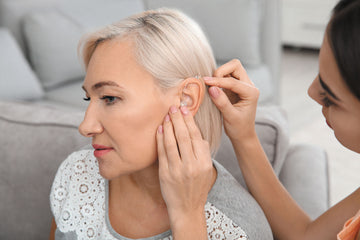When it comes to hearing assistance devices, patients have a variety of options. The three most common types are Hearing Amplifiers, Hearing Aids, and OTC (Over-the-Counter) Hearing Aids. Choosing the right device according to individual hearing conditions is crucial since using the wrong type may lead to further hearing damage.
For instance, individuals with severe hearing loss or conductive hearing issues should opt for professional hearing aids instead of amplifiers. Hearing amplifiers merely amplify sound and are more suitable for elderly users with mild hearing loss or hearing difficulty. OTC Hearing Aids, on the other hand, is a new budget choice for people with mild to moderate hearing loss This article explains the differences among the three types of devices to help you make a more informed choice.

What are Hearing Amplifiers
Hearing amplifiers are low-cost sound enhancement tools designed to amplify environmental sounds. They are ideal for individuals with mild hearing decline or those who temporarily need better hearing (e.g., elderly people, conference attendees). These are not medical-grade hearing aids but rather consumer electronic products, usually ready to use without professional fitting.
Compared with professional hearing aids, hearing amplifiers offer only basic amplification. They do not perform well in complex sound environments like noisy places, and improper volume control may even lead to further hearing damage over time. People with moderate to severe hearing loss should opt for professional OTC hearing aids instead.
Buying Tips:
- Avoid excessive volume amplification
- Choose mid-to-high-end models with noise reduction and Bluetooth functionality
- If hearing loss significantly affects your life, consult an audiologist to prevent delayed treatment
What Are Prescription Hearing Aids?
Prescription Hearing aids are medically certified electronic devices designed for individuals with hearing loss. These devices must be fitted professionally and use advanced sound processing technologies such as noise reduction and frequency compensation. Classified as medical devices, hearing aids must be fitted according to individual audiograms and are suitable for all degrees of hearing loss—from mild to profound.
Unlike regular amplifiers, Linner Saturn 2 OTC hearing aids can differentiate between speech and background noise, selectively amplifying essential sounds while minimizing feedback. They deliver a clear and natural listening experience. While more expensive (typically ranging from thousands to tens of thousands of dollars), they provide long-term hearing protection and professional after-sales service.
Ideal Users:
- Elderly individuals with moderate to profound hearing loss
- Patients with conductive hearing loss
What Are OTC Hearing Aids?
OTC (Over-the-Counter) Hearing Aids are a new category approved by the U.S. FDA in 2022, designed for adults (18+) with mild to moderate hearing loss. These devices do not require a prescription or fitting from an audiologist and can be purchased directly from drugstores, e-commerce sites, or retail outlets, make it an ideal choice before you go for a prescription hearing aids.
Compared with professional hearing aids, OTC hearing aids offer three key advantages:
- Standardized design: Includes preset amplification modes for easy adjustment
- Affordable price: Usually priced between $100 and $1000
- Modern features: Many include Bluetooth connectivity and environmental mode switching
Limitations:
- Not suitable for severe hearing loss (hearing threshold above certain decibels), children, or specific types of hearing disorders such as conductive hearing loss
FDA regulations require these devices to include volume control, maximum output limits, and other safety functions to protect residual hearing.
Buying Tips:
- Look for the FDA certification mark
- Choose based on your hearing profile and needs
Main difference Between Them
Beyond basic functionality and user profiles, the table below compares them in detail:
| Feature | Hearing Amplifiers | OTC Hearing Aids | Prescription Hearing Aids |
| Regulation | Consumer electronics | FDA regulated, No prescription required | FDA regulated |
| Target Users | Mild hearing loss | Mild to moderate hearing loss | All degrees of hearing loss |
| Sound Processing | Basic amplification | Basic DSP, some noise reduction | Advanced DSP, feedback control |
| Fitting Needed | No fitting required | Presets or Self-fitting | Professionally fitted |
| Price Range($) | 50−300 | 100−2000 | 5000+ |
| Best For | Daily assistance | Budget-conscious users with moderate hearing loss | Precise hearing compensation |
Tips:
- OTC hearing aids are a middle-ground solution between amplifiers and professional devices
- Children and people with severe hearing loss must use professional hearing aids
Tips for Buying a Hearing Device
Choosing the wrong device, whether OTC or professional, can worsen your hearing condition or cause ear discomfort. Here are some important tips:
- Get a professional hearing test Visit a hospital or hearing center for pure-tone audiometry and speech recognition tests. Confirm the type (conductive/sensorineural) and degree of hearing loss. Moderate to severe loss (average threshold >40 dB) or children must use medical-grade devices. OTC products may delay treatment.
- Beware of unknown brands Stick to trusted brands like Phonak or Siemens. Unreliable brands may worsen your hearing instead of improving it.
- Prioritize essential features Before purchasing, contact customer service to confirm key functions. Must-have features include multi-channel compression, feedback suppression, and at least IP68 waterproofing. If you're buying an OTC model, consult support to find the right fit.
Best OTC Hearing Aids You Need to Know
There are many OTC hearing aids on the market, but LINNER is highly recommended. Our products are designed for users with mild-to-moderate hearing loss (average threshold 30–55 dB). Compared with other brands, we offer the best price-performance ratio and excellent user feedback.
Key Features:
- Digital Signal Processing (DSP): Offers basic noise reduction and feedback control
- Multi-level volume adjustment: Controlled via button or app (some models support Bluetooth)
- Universal ear tips: Comfortable silicone ear tips (non-custom molds)
Welcome to shop with us!
FAQ: Hearing Amplifiers
1. What are the types of hearing amplifiers?
By wearing style, hearing amplifiers can be divided into BTE (Behind-the-Ear), ITE (In-the-Ear), and Neckband types:
BTE: Worn behind the ear with a tube connecting to the earpiece. Large size, long battery life. Best for extended wear and outdoor use.
ITE: Fits directly into the ear canal. More discreet but may cause pressure. Better for short-term wear.
Neckband: Worn like Bluetooth earphones around the neck. Some models support music and calls. Ideal for exercise or commuting.
2. Is it bad to wear hearing aids all the time?
Proper long-term use of hearing aids does not harm the ears. In fact, it improves hearing and reduces negative effects caused by hearing loss. But they must be fitted and used correctly, with regular maintenance. If discomfort arises, consult a hearing specialist promptly.
Related:OTC Hearing Aids: What Are They and Why Choose Them?
BTE vs RIC Hearing Aids 2025 – Which Fits Your Hearing Needs Better?





